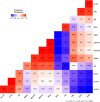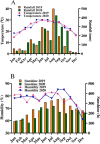An insight to rhizosphere bacterial community composition and structure of consecutive winter-initiated sugarcane ratoon crop in Southern China
- PMID: 35183114
- PMCID: PMC8857817
- DOI: 10.1186/s12870-022-03463-6
An insight to rhizosphere bacterial community composition and structure of consecutive winter-initiated sugarcane ratoon crop in Southern China
Abstract
Background: Ratooning in sugarcane is a crucial strategy for ensuring the long-term sustainability of the sugarcane industry. Knowledge gap relating to the interaction between rhizosphere microbiome and ratooning crop, particularly the impact of different sugarcane cultivars on the rhizosphere microbiome in consecutive ratooning, requires additional research. The response of two different sugarcane cultivars, viz ZZ-1 and ZZ-13, were evaluated in consecutive ratooning towards the rhizosphere microbial community and cane morphological characters.
Results: Significant changes in the rhizosphere microbiome were observed in the second ratooning over the years. Several important genera were observed in high abundance during the second ratooning, including Burkholderia, Sphingomonas, Bradyzhizobium, and Acidothermus. Cultivar ZZ-13 caused more alterations in the rhizosphere microbiome than ZZ-1, resulting in a more favorable rhizosphere environment for sugarcane growth. The genotypes also varied in terms of nutrients and enzyme activity over the years. There were significant differences between the genotypes and year for number of stalks and yield was significant for genotypes, years and genotype × year.
Conclusion: This finding will help to understand thorough interactions between rhizosphere microorganisms and ratoon sugarcane and lay the foundation for promoting and maximizing yield as far as possible. In the future, this work can serve as guidance in sugarcane husbandry, mainly in Guangxi, China.
Keywords: Ratoon crop; Rhizosphere; Soil enzymes; Sugarcane; Yield.
© 2022. The Author(s).
Conflict of interest statement
The authors declare no conflict of interest.
Figures








Similar articles
-
Dynamics of rhizosphere bacterial communities and soil physiochemical properties in response to consecutive ratooning of sugarcane.Front Microbiol. 2023 Jul 10;14:1197246. doi: 10.3389/fmicb.2023.1197246. eCollection 2023. Front Microbiol. 2023. PMID: 37492263 Free PMC article.
-
Rhizosphere Bacterial Community Characteristics over Different Years of Sugarcane Ratooning in Consecutive Monoculture.Biomed Res Int. 2019 Nov 11;2019:4943150. doi: 10.1155/2019/4943150. eCollection 2019. Biomed Res Int. 2019. PMID: 31815142 Free PMC article.
-
Whole genome sequence insight of two plant growth-promoting bacteria (B. subtilis BS87 and B. megaterium BM89) isolated and characterized from sugarcane rhizosphere depicting better crop yield potentiality.Microbiol Res. 2021 Jun;247:126733. doi: 10.1016/j.micres.2021.126733. Epub 2021 Mar 1. Microbiol Res. 2021. PMID: 33676313
-
Sugarcane Ratooning Ability: Research Status, Shortcomings, and Prospects.Biology (Basel). 2021 Oct 15;10(10):1052. doi: 10.3390/biology10101052. Biology (Basel). 2021. PMID: 34681151 Free PMC article. Review.
-
Ecological occurrence of Gluconacetobacter diazotrophicus and nitrogen-fixing Acetobacteraceae members: their possible role in plant growth promotion.Microb Ecol. 2008 Jan;55(1):130-40. doi: 10.1007/s00248-007-9258-6. Epub 2007 Jun 17. Microb Ecol. 2008. PMID: 17574542 Review.
Cited by
-
Directly replanting with GF296 extends the years of ratooning and yield in sugarcane.Sci Rep. 2025 Jul 8;15(1):24392. doi: 10.1038/s41598-025-09294-3. Sci Rep. 2025. PMID: 40628848 Free PMC article.
-
Dynamics of rhizosphere bacterial communities and soil physiochemical properties in response to consecutive ratooning of sugarcane.Front Microbiol. 2023 Jul 10;14:1197246. doi: 10.3389/fmicb.2023.1197246. eCollection 2023. Front Microbiol. 2023. PMID: 37492263 Free PMC article.
-
Correlation of microbiomes in "plant-insect-soil" ecosystem.Front Microbiol. 2023 Jan 30;14:1088532. doi: 10.3389/fmicb.2023.1088532. eCollection 2023. Front Microbiol. 2023. PMID: 36793880 Free PMC article.
-
Untangling the Rhizosphere Bacterial Community Composition and Response of Soil Physiochemical Properties to Different Nitrogen Applications in Sugarcane Field.Front Microbiol. 2022 Mar 14;13:856078. doi: 10.3389/fmicb.2022.856078. eCollection 2022. Front Microbiol. 2022. PMID: 35369493 Free PMC article.
-
Analysis of Microbial Diversity and Community Structure of Rhizosphere Soil of Three Astragalus Species Grown in Special High-Cold Environment of Northwestern Yunnan, China.Microorganisms. 2024 Mar 7;12(3):539. doi: 10.3390/microorganisms12030539. Microorganisms. 2024. PMID: 38543590 Free PMC article.
References
-
- Li YR, Yang LT. Sugarcane agriculture and sugar industry in China. Sugar Tech. 2015;17(1):1–8. doi: 10.1155/2019/4943150. - DOI
-
- Chumphu S, Jongrungklang N, Songsri P. Association of physiological responses and root distribution patterns of ratooning ability and yield of the second ratoon cane in sugarcane elite clones. Agron. 2019;9(4):200. doi: 10.3390/agronomy9040200. - DOI
-
- Mehareb EM, Abou-Elwafa SF, Galal MO. Mean performance and Ratooning ability of sugarcane promising genotypes at early clonal selection. Am Eurasian J Agric Environ Sci 2016;16(1):12850 https://doi.5829/idosi.aejaes.2016.16.1.12850
MeSH terms
Substances
LinkOut - more resources
Full Text Sources
Miscellaneous

